Islamic Middle Ages Pottery from Muge (Portugal), Serradinho Archaeological Site—A Long-Lasting Tradition of Pottery Production
Abstract
:1. Introduction
2. Geological Setting
3. Materials and Methods
3.1. Archaeological Ceramic Retrieval Context and Analysed Samples
3.2. Sediment Sampling
3.3. Methods
4. Results and Discussion
4.1. Archaeological Ceramics
4.1.1. Optical Microscopy (OM)
OM Results Identified Three Different Ceramic Fabrics
4.1.2. Powder X-Ray Diffraction Results of Ceramic Samples—P-XRD
4.1.3. X-Ray Fluorescence Results of Ceramic Samples—XRF
4.1.4. SEM-EDS of the Glazed Decoration (Sample 50)
4.2. Raw Materials
4.2.1. Granulometry
4.2.2. Powder X-Ray Diffraction Results of Clay Raw Materials—P-XRD
4.2.3. X-Ray Fluorescence Results of Clay Raw Materials—XRF
5. Comparing Ceramic and Sediments XRF Results
6. Conclusions
Supplementary Materials
Author Contributions
Funding
Institutional Review Board Statement
Informed Consent Statement
Data Availability Statement
Acknowledgments
Conflicts of Interest
References
- Beltrame, M. CALIPH: Comprehensive Archaeological and Laboratory Investigation of Islamic Pottery in Portuguese History. Ph.D. Thesis, University of Evora, Evora, Portugal, 2022. Available online: https://dspace.uevora.pt/rdpc/handle/10174/31377 (accessed on 12 September 2024).
- Alves, M.S. Ocupação humana e polarização de um espaço rural do Gharb al-Andalus: O Médio Tejo à luz da toponímia árabica. In Arquipélago. História, 2a Série; Universidade dos Açores: Azores, Portugal, 1997; Volume 2, pp. 353–385. ISSN 0871-7664. Available online: https://hdl.handle.net/10400.3/474 (accessed on 5 October 2024).
- Molina, L. Una Descripción Anónima de al-Andalus (Dikr bilad al-Andalus); Consejo Superior de Investigaciones Científicas/Instituto Miguel Asín: Madrid, Spain, 1983. [Google Scholar]
- Carvalho, J.D.R. Santarém e a Reconquista: A Tomada da Cidade em. Master’s Thesis, University of Lisbon, Lisbon, Portugal, 2022. Available online: https://repositorio.ulisboa.pt/handle/10451/51698 (accessed on 6 October 2024).
- Alves, M.S. Uma Paisagem Humanizada. O Médio Tejo nos Finais da Idade Média I; Patrimonia Historica: Cascais, Portugal, 2000. [Google Scholar]
- Viana, M. A evolução do povoamento em Santarém na Idade Média e a sua relação com a área periurbana. In Terceiras Jornadas de História sobre Paisagens Rurais e Urbanas: Fontes, Metodologias, Problemáticas, 2005; Gonçalves, I., Ed.; Centro de Estudos Históricos da Universidade Nova de Lisboa: Lisbon, Portugal, 2007; pp. 83–108. [Google Scholar]
- Liberato, M. Novos dados sobre a paisagem urbana da Santarém medieval (séculos V-XII): A necrópole visigoda e islámica de Alporão. Medievalista 2012, 11, 1–23. [Google Scholar] [CrossRef]
- Lopes, G. Materiais do povoado Islâmico do Serradinho (Muge, Salvaterra de Magos). In Cira Arqueologia; Roque, F., Ed.; Câmara Municipal de Vila Franca de Xira and Museu Municipal: Vila Franca de Xira, Portugal, 2015; Volume 4, pp. 171–186. ISSN 2183069X. [Google Scholar]
- Alves, M.S. Fronteira, guerra e organização social do espaço: O Vale do Tejo, entre muçulmanos e cristãos (séculos IX-XIII). In Muçulmanos e Cristãos entre o Tejo e o Douro (Sécs. VIII a XIII); Barroca, M.J., Fernandes, I.C.F., Eds.; Câmara Municipal de Palmela/Facultade de Letras da Universidade do Porto: Palmela, Portugal, 2005; pp. 43–52. [Google Scholar]
- Lopes, G. A propriedade régia em Muge durante a Idade Média. In Magos-Revista Cultural do Concelho de Salvaterra de Magos; Esménio, H.M., Ed.; Câmara Municipal de Salvaterra de Magos: Salvaterra de Magos, Portugal, 2018; Volume 5, pp. 3–28, Legal Deposit 380652/14. [Google Scholar]
- Pinto, C.M.G. Gestos, Memórias e Formas Materiais Legadas Pelo Barro: A Produção Olárica no Ribatejo na Coleção de Olaria Tradicional do Museu Nacional de Etnología. Master’s Thesis, NOVA University Lisbon, Lisbon, Portugal, 2012. Available online: https://hdl.handle.net/10362/7754 (accessed on 15 October 2024).
- Vasconcellos, J.L. Ceramica Portuguesa. Serie II, Estudos e Documentos Inéditos; Typographia Elzeviriana: Porto, Portugal, 1884. [Google Scholar]
- Lepierre, C. Estudo Chimico e Technologico Sobre a Ceramica Portugueza Moderna; Imprensa Nacional: Lisbon, Portugal, 1899.
- Santos Júnior, J.R. Olarias de Muge (notas etnográficas). In Trabalhos da Sociedade Portuguesa de Antropologia e Etnologia; Imprensa Portuguesa: Porto, Portugal, 1932; Volume 5 (III), pp. 217–230. [Google Scholar]
- Cardoso, G.; Batalha, L. Mestre Domingos Gonçalves da Silva: Um oleiro tradicional de Muge, Salvaterra de Magos. Al-Madam 2020, 23, 40–47. [Google Scholar]
- Beltrame, M.; Liberato, M.; Mirão, J.; Santos, H.; Barrulas, P.; Branco, F.; Gonçalves, L.; Candeias, A.; Schiavon, N. Islamic and post Islamic ceramics from the town of Santarém (Portugal): The continuity of ceramic technology in a transforming society. J. Archaeol. Sci. Rep. 2019, 23, 910–928. [Google Scholar] [CrossRef]
- Beltrame, M.; Sitzia, F.; Arruda, A.M.; Barrulas, P.; Barata, F.T.; Mirão, J. The Islamic ceramic of the Santarém Alcaçova: Raw materials, technology, and trade. Archaeometry 2021, 63, 1157–1177. [Google Scholar] [CrossRef]
- Cunha, P.P. Cenozoic basins of Western Iberia: Mondego, lower Tejo and Alvalade basins. In The Geology of Iberia: A Geodynamic Approach, Regional Geology Reviews; Quesada, C., Oliveira, J.T., Eds.; Springer International Publishing: Cham, Switzerland, 2019; Volume 4: Cenozoic Basins, pp. 105–130. [Google Scholar] [CrossRef]
- Cunha, P.P.; Martins, A.A.; Daveau, S.; Friend, P.F. Tectonic control of the Tejo river fluvial incision during the late Cenozoic, in Ródão-central Portugal (Atlantic Iberian border). Geomorphology 2005, 64, 271–298. [Google Scholar] [CrossRef]
- Pais, J. The neogene of the lower Tagus basin (Portugal). Revista Esp. Paleont. 2004, 19, 229–242. [Google Scholar] [CrossRef]
- Zbyszewski, G. Carta Geológica de Portugal na Escala de 1: Map 31-A Santarém Explicative Notes. Serviços Geológicos de Portugal: Lisbon, Portugal, 1952; Available online: https://geoportal.lneg.pt/download/maps/50k/news/31-A.pdf (accessed on 18 September 2024).
- Zbyszewski, G.; Da Veiga, O. Carta Geológica de Portugal na Escala de 1: Map 31-C Coruche Explicative Notes; Serviços Geológicos de Portugal, Lisbon, Portugal. Available online: https://geoportal.lneg.pt/download/maps/50k/news/31-C.pdf (accessed on 23 September 2024).
- Beltrame, M.; Sitzia, F.; Liberato, M.; Santos, H.; Themudo, F.; Columbu, S.; Mirão, J. Comparative pottery technology between the Middle Ages and Modern times (Santarém, Portugal). Archaeol. Anthropol. Sci. 2020, 12, 1–31. [Google Scholar] [CrossRef]
- Quinn, P.S. Ceramic Petrography: The Interpretation of Archaeological Pottery & Related Artefacts in Thin Section, 1st ed.; Archaeopress: Oxford, UK, 2013; ISBN 978-1-905739-59-2. [Google Scholar]
- Adams, A.E.; MacKenzie, W.S.; Guilford, C. Atlas of Sedimentary Rocks Under the Microscope, 1st ed.; Longman Group: London, UK, 1984; ISBN 0-582-02701-2. [Google Scholar]
- Camara, C.; Gonçalves, M.J.; Mirão, J.A.; Gómez, S.M.; Beltrame, M. Morpho-functional, decorative and petrographic study of glazed/unglazed Islamic ceramics from the cities of Évora, Mértola and Silves. Estud. Quaternário/Quat. Stud. 2023, 23, 29–46. [Google Scholar] [CrossRef]
- Hubbard, C.R.; Evans, E.H.; Smith, D.K. The reference intensity ratio, I/I c, for computer simulated powder patterns. J. Appl. Cryst. 1976, 9, 169–174. [Google Scholar] [CrossRef]
- Camara, C.A.; Gonçalves, M.J.; Mirão, J.A.; Gómez, S.M.; Beltrame, M. High-lead glazed ceramic production in Western Iberia (Gharb al-Andalus) between the 10th and mid-13th centuries. An approach from the city of Évora (Portugal). Ceramics 2023, 6, 2213–2242. [Google Scholar] [CrossRef]
- Schiavon, N.; Soria, V.; Arruda, A.M.; Beltrame, M.; Mirão, J. “Losanga” decorated imitations of italic late republican black gloss tableware from South-Western Iberia: A multi-analytical/microchemical characterization. Microchem. J. 2016, 124, 712–718. [Google Scholar] [CrossRef]
- Duminuco, P.; Messiga, B.; Riccardi, M.P. Firing process of natural clays. Some microtextures and related phase compositions. Thermochim. Acta 1998, 321, 185–190. [Google Scholar] [CrossRef]
- Riccardi, M.P.; Messiga, B.; Duminuco, P. An approach to the dynamics of clay firing. Appl. Clay Sci. 1999, 15, 393–409. [Google Scholar] [CrossRef]
- Cultrone, G.; Rodriguez-Navarro, C.; Sebastian, E.; Cazalla, O.; De La Torre, M.J. Carbonate and silicate phase reactions during ceramic firing. Eur. J. Mineral. 2001, 13, 621–634. [Google Scholar] [CrossRef]
- Trindade, M.J.; Dias, M.I.; Coroado, J.; Rocha, F. Mineralogical transformation of calcareous rich clays with firing: A comparative study between calcite and dolomite rich clays from Algarve, Portugal. Appl. Clay Sci. 2009, 42, 345–355. [Google Scholar] [CrossRef]
- El Ouahabi, M.; Daoudi, L.; Hatert, F.; Fagel, N. Modified mineral phases during clay ceramic firing. Clays Clay Miner. 2015, 63, 404–413. [Google Scholar] [CrossRef]
- Heimann, R.B.; Maggetti, M. The struggle between thermodynamics and kinetics: Phase evolution of ancient and historical ceramics. Eur. Mineral. Union Notes Mineral. 2019, 20, 233–281. [Google Scholar] [CrossRef]
- Molera, J.; García-Vallés, M.; Pradell, T.; Vendrell-Saz, M. Hispano-Moresque pottery production of the fourteenth-century workshop of Testar del Molí (Paterna, Spain). Archaeometry 1996, 38, 67–80. [Google Scholar] [CrossRef]
- Tite, M.S.; Freestone, I.; Mason, R.; Molera, J.; Vendrell-Saz, M.; Wood, N. Lead glazes in antiquity. Methods of production and reasons for use. Archaeometry 1998, 40, 241–260. [Google Scholar] [CrossRef]
- Pradell, T.; Molera, J. Ceramic technology. How to characterize ceramic glazes. Archaeol. Anthropol. Sci. 2020, 12, 1–28. [Google Scholar] [CrossRef]
- Nodari, L.; Marcuz, E.; Maritan, L.; Mazzoli, C.; Russo, U. Hematite nucleation and growth in the firing of carbonate-rich clay for pottery production. J. Eur. Ceram. Soc. 2007, 27, 4665–4673. [Google Scholar] [CrossRef]
- Peréz-Arantegui, J.; Uruñuela, M.I.; Castillo, J.R. Roman glazed ceramics in the Western Mediterranean: Chemical characterization by inductively coupled plasma atomic emission spectrometry of ceramic bodies. J. Archaeol. Sci. 1996, 23, 903–914. [Google Scholar] [CrossRef]
- Déléry, C. Using cuerda seca ceramics as a historical source to evaluate trade and cultural relations between Christian ruled lands and Al-Andalus, from the tenth to thirteenth centuries. Al-Masāq 2009, 21, 31–58. [Google Scholar] [CrossRef]
- Chapoulie, R.; Déléry, C.; Daniel, F.; Vendrell-Saz, M. Cuerda seca ceramics from Al-Andalus, Islamic Spain and Portugal (10th-12th centuries AD): Investigation with SEM-EDX and cathodoluminescence. Archaeometry 2005, 47, 519–534. [Google Scholar] [CrossRef]
- Molera, J.; Pradell, T.; Salvadó, N.; Vendrell-Saz, M. Interactions between clay bodies and lead glazes. J. Am. Ceram. Soc. 2001, 84, 1120–1128. [Google Scholar] [CrossRef]
- Molera, J.; Pradell, T.; Salvadó, N.; Vendrell, M. Lead frits in Islamic and Hispano-moresque glazed productions. In From Mine to Microscope: Advances in the Study of Ancient Technology, 1st ed.; Shortland, A.J., Freestone, I.C., Rehren, T., Eds.; Oxbow Books: Oxford, UK, 2007; pp. 1–10. ISBN 978-184217-259-9. [Google Scholar]
- Salinas, E.; Pradell, T.; Molera, J. Glaze production at early Islamic workshop in al-Andalus. Archaeol. Anthropol. Sci. 2018, 11, 2201–2213. [Google Scholar] [CrossRef]
- Vendrell-Saz, M.; Molera, J.; Tite, M.S. Optical Properties of Tin-Opacified Glazes. Archaeometry 2000, 42, 325–340. [Google Scholar] [CrossRef]
- Vendrell-Saz, M.; Molera, J.; Roqué, J.; Peréz-Arantegui, J. Islamic and Hispano-Moresque (múdejar) lead glazes in Spain: A technical approach. Geol. Soc. 2006, 257, 163–173. [Google Scholar] [CrossRef]
- Molera, J.; Pradell, T.; Merino, L.; García-Vallés, M.; García-Orellana, J.; Salvadó, N.; Vendrell-Saz, M. La tecnología de la cerámica Islámica y Mudéjar. Caesaraugusta 1997, 73, 15–41. [Google Scholar]
- Murad, E. Yttrium and zirconium as geochemical guide elements in soil and stream sediment sequences. J. Soil Sci. 1978, 29, 219–223. [Google Scholar] [CrossRef]
- Fedo, C.M.; Sircombe, K.N.; Rainbird, R.H. Detrital zircon analysis of the sedimentary record. Rev. Mineral. Geochem. 2003, 53, 277–303. [Google Scholar] [CrossRef]
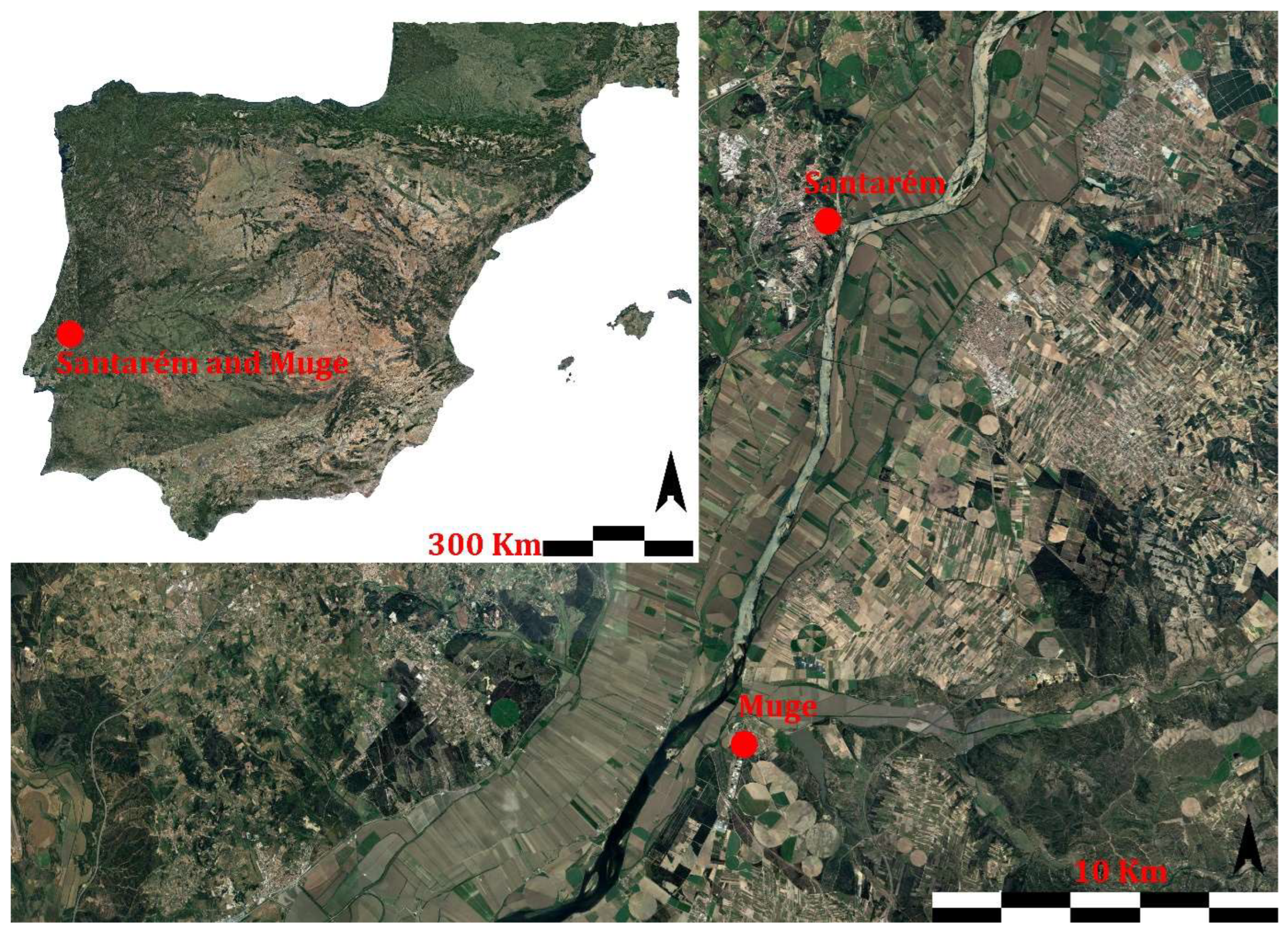
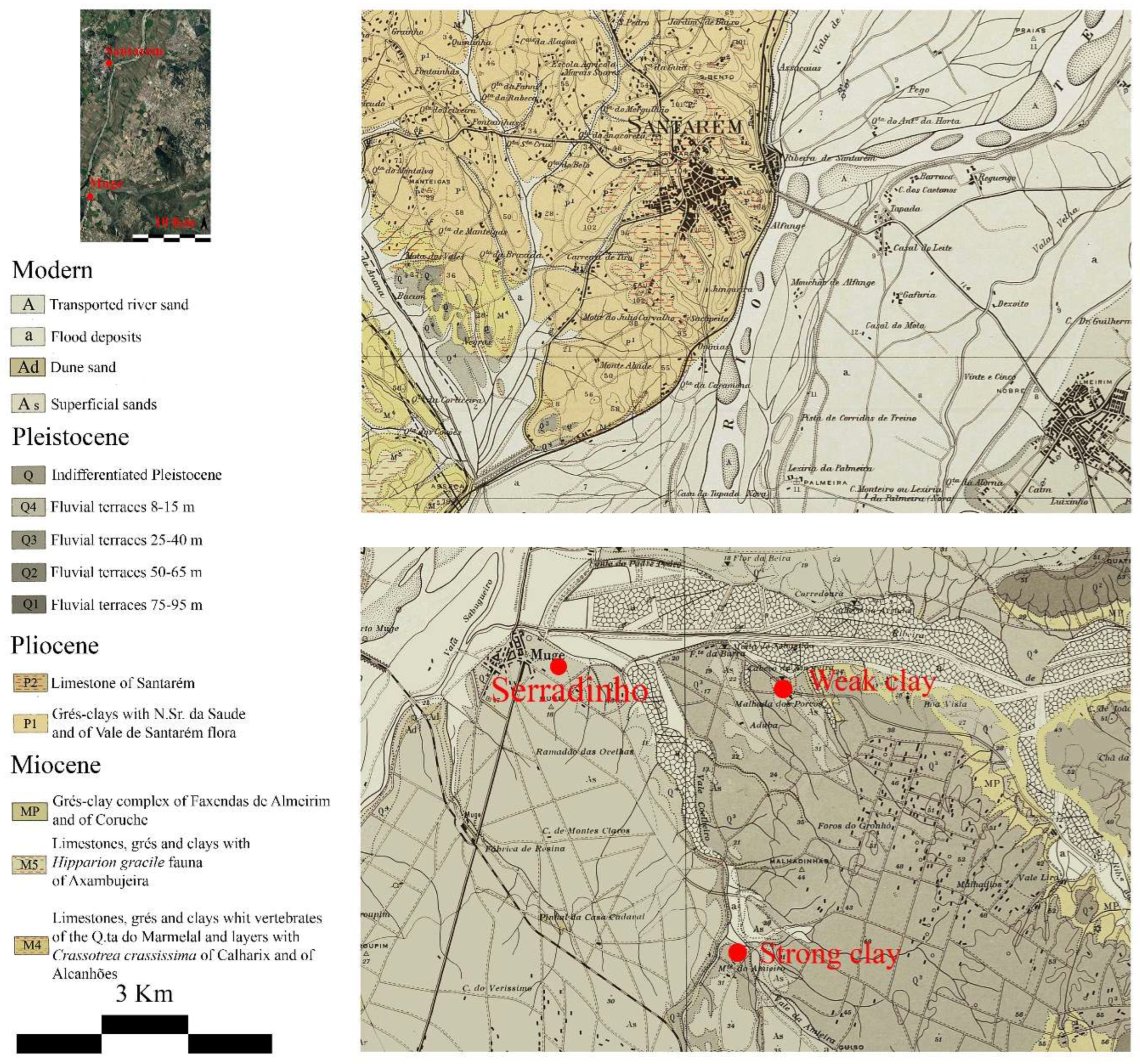

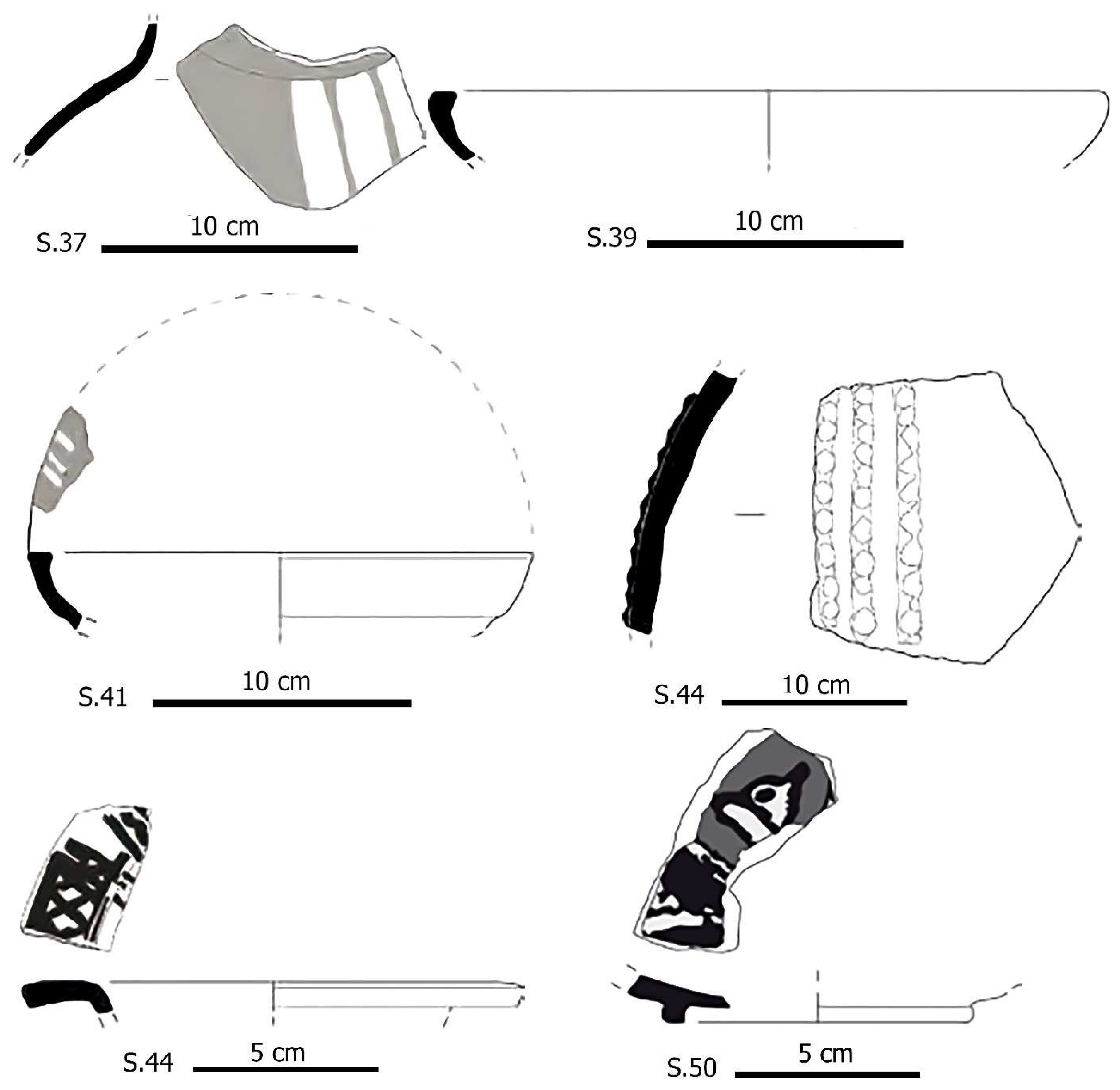
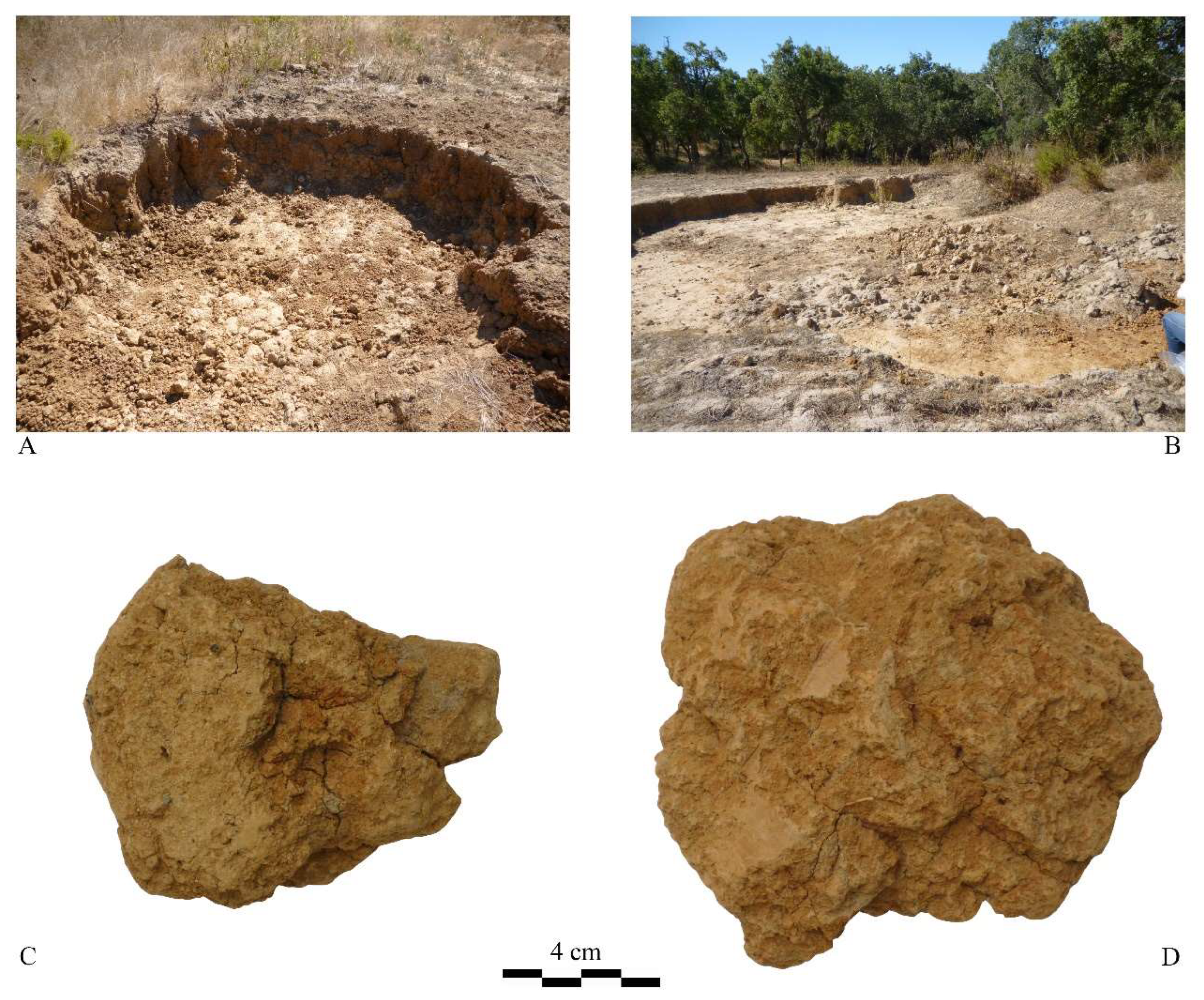
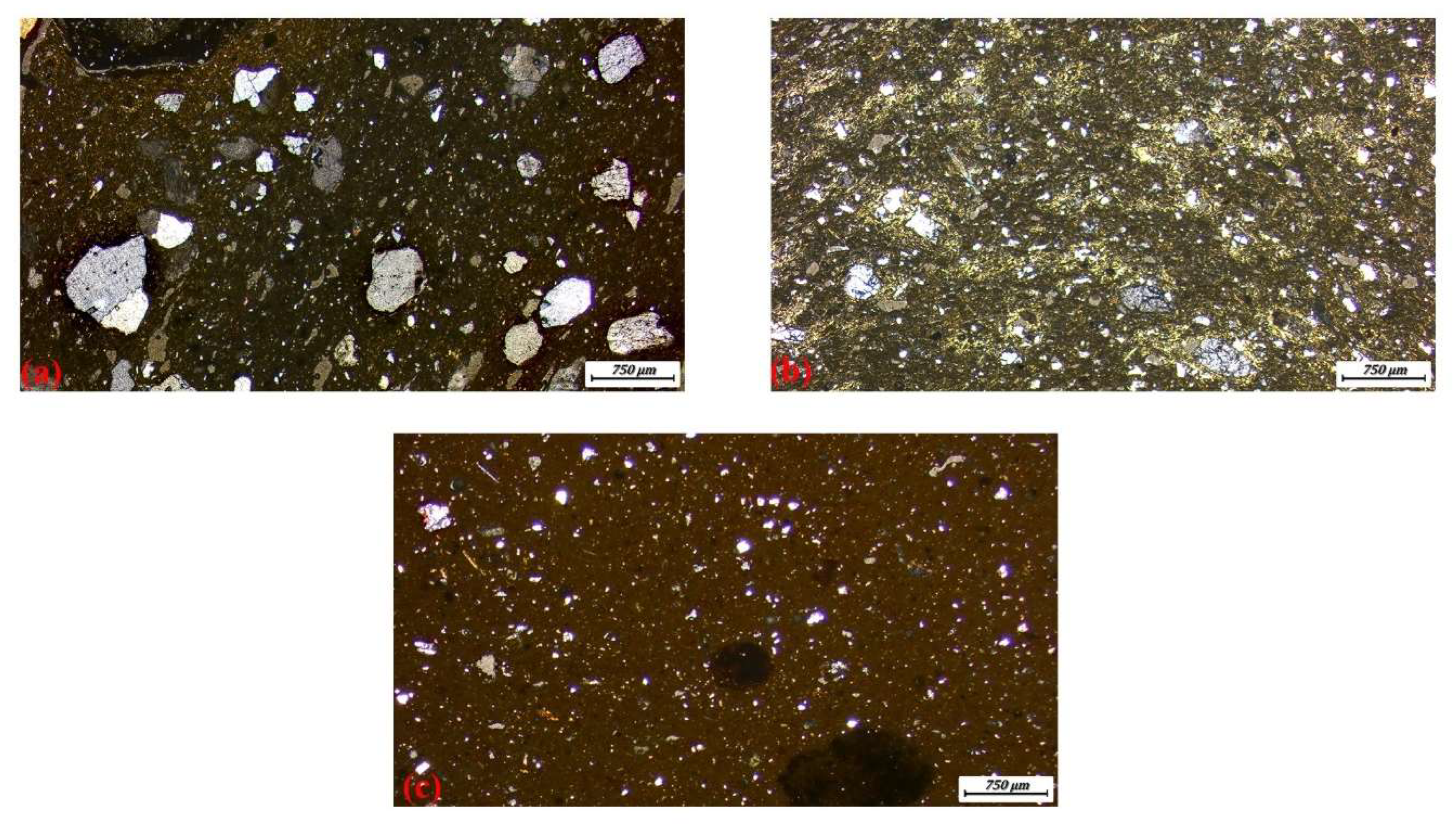
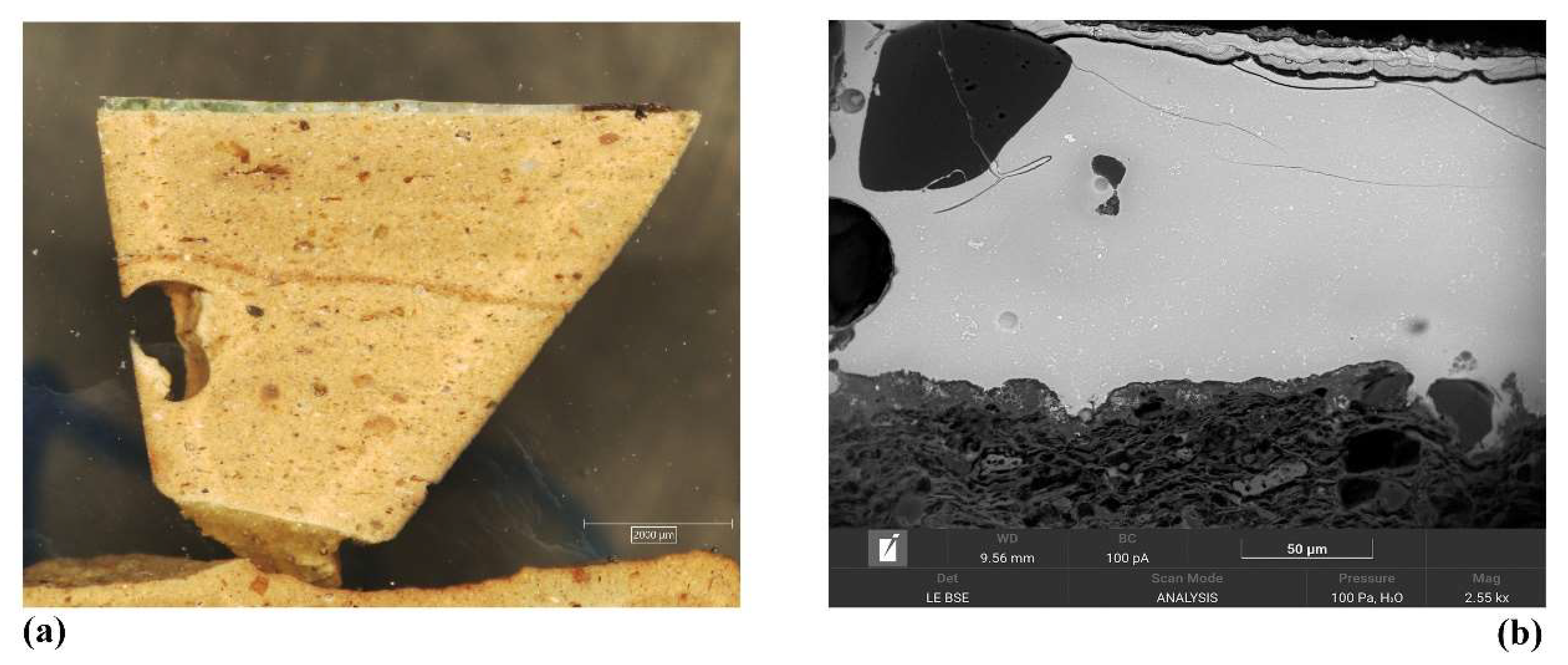
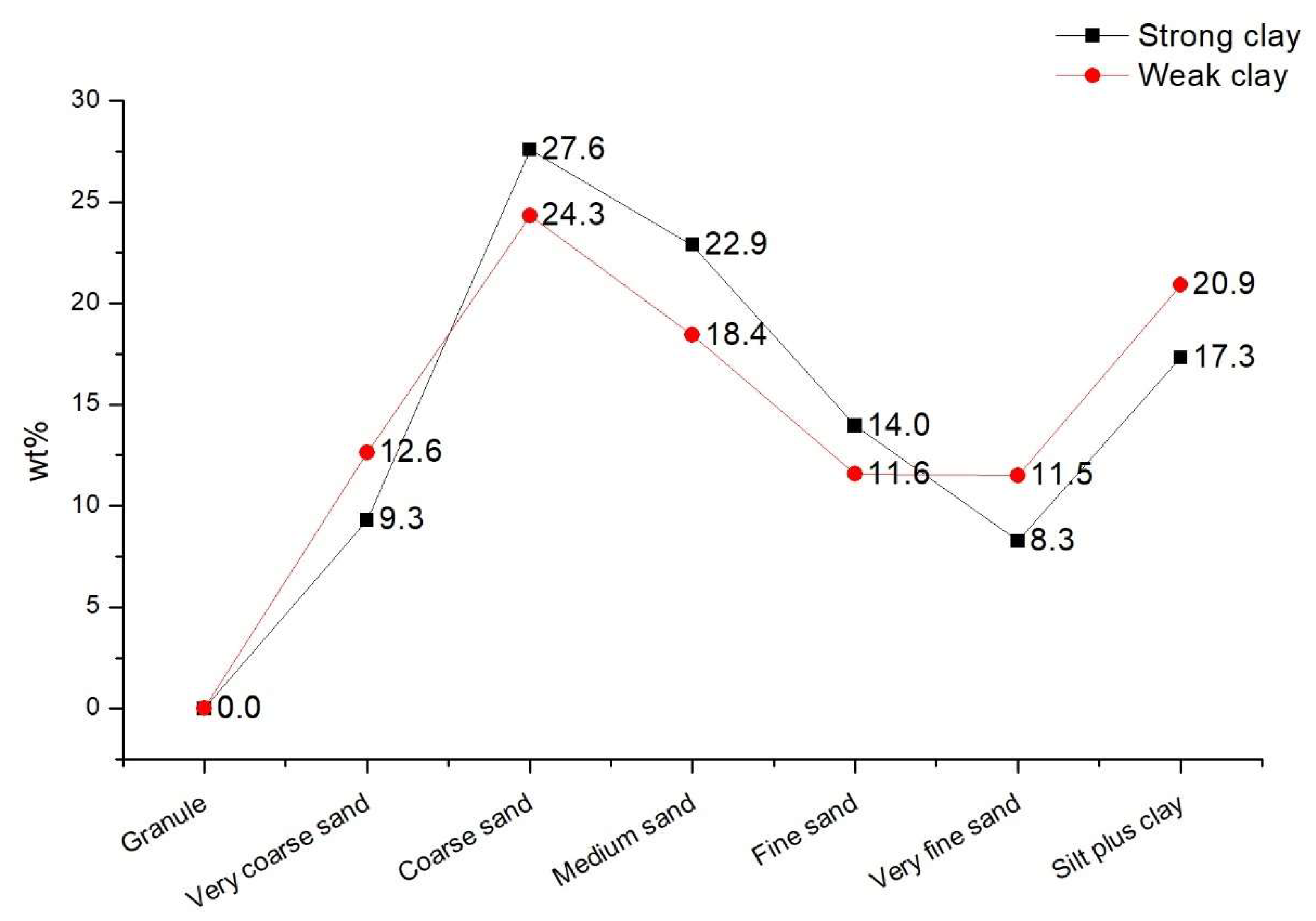

| Reference | General Classification | Typology | Function | Decoration | Century | Period | Ref. in [8] Lopes |
|---|---|---|---|---|---|---|---|
| Sample 1 | Common ware | Cooking pot “Panela” | Fire ceramic | None | 9–10th | Emiral? | Drawing 1—Figure 6 (p. 177) |
| Sample 2 | Common ware | Cooking pot “Panela” | Fire ceramic | None | 9–12th | Taifa/Almoravid | Drawing 2—Figure 6 (p. 177) |
| Sample 12 | Common ware | Cooking pot “Panela” | Fire ceramic | White painted | 11–12th | Taifa/Almoravid | Drawing 12—Figure 6 (p. 177) |
| Sample 15 | Light coloured | Little jar | Liquid container | Red painted | 11th | Taifa | Drawing 15—Figure 8 (p. 179) |
| Sample 19 | Common ware | Little jar | Liquid container | White painted | 11–12th | Taifa/Almoravid | Drawing 19—Figure 8 (p. 179) |
| Sample 26 | Common ware | Big jar | Liquid container | None | 10–11th? | Caliphal/Taifa? | Drawing 26—Figure 9 (p. 179) |
| Sample 30 | Common ware | Big jar | Liquid container | Incisions | 11–12th? | Taifa/Almoravid? | Drawing 30—Figure 9 (p. 179) |
| Sample 31 | Common ware | Big jar | Liquid container | Incisions | 11–12th? | Taifa/Almoravid? | Drawing 31—Figure 9 (p. 179) |
| Sample 35 | Common ware | Big jar | Liquid container | White painted | 12th | Almoravid | Drawing 35—Figure 9 (p. 179) |
| Sample 37 | Common ware | Big jar | Liquid container | White painted | 12th | Almoravid | Drawing 37—Figure 9 (p. 179) |
| Sample 39 | Common ware | Cooking pot “Caçoilas e/o Tijelas” | Fire ceramic | None | 10–12th | Caliphal/Taifa | Drawing 39—Figure 10 (p. 180) |
| Sample 41 | Common ware | Cooking pot “Caçoilas e/o Tijelas” | Fire ceramic | White painted | 11–12th | Taifa/Almoravid | Drawing 41—Figure 10 (p. 180) |
| Sample 44 | Common ware | Big earthen pot | Storage ceramic | Moulded plastic decoration | 10–11th | Caliphal/Taifa | Drawing 44—Figure 12 (p. 181) |
| Sample 48 | Light- coloured | Bowl | Table ware | Red painted | 10–11th | Caliphal/Taifa | Drawing 48—Figure 15 (p. 183) |
| Sample 50 | Light- coloured | Bowl | Table ware | Cuerda seca | 12th | Almoravid | Drawing 50—Figure 17 (p. 183) |
| ICDD Reference Code | 01-080-0743 | 01-072-0469 | 01-075-1092 | 01-076-0831 | 00-009-0469 | 00-041-1486 | 01-080-0743 | 01-087-0049 | 01-075-1756 | 01-085-2157 | ||
|---|---|---|---|---|---|---|---|---|---|---|---|---|
| Sample | Fabric | XRD Group | Q | H | Py | Kf | Na-Pl | Ca-Pl | Ill/Mus | Ak | Rut | Amp |
| Sample 1 | 1 | 1 | 60 | 1 | 23 | 4 | 11 | |||||
| Sample 2 | 1 | 1 | 55 | 6 | 27 | 3 | 13 | 1 | ||||
| Sample 12 | 1 | 1 | 57 | 1 | 20 | 3 | 19 | 1 | ||||
| Sample 15 | 2 | 1 | 57 | 1 | 22 | 2 | 17 | 1 | ||||
| Sample 19 | 1 | 1 | 61 | 1 | 20 | 6 | 12 | 1 | ||||
| Sample 26 | 1 | 1 | 50 | 1 | 32 | 3 | 14 | 1 | ||||
| Sample 30 | 1 | 1 | 59 | 1 | 23 | 3 | 15 | |||||
| Sample 31 | 1 | 1 | 61 | 1 | 21 | 2 | 15 | |||||
| Sample 35 | 1 | 1 | 63 | 1 | 18 | 5 | 12 | 1 | ||||
| Sample 37 | 1 | 1 | 66 | 1 | 21 | 2 | 11 | |||||
| Sample 39 | 1 | 1 | 57 | 1 | 22 | 4 | 16 | |||||
| Sample 41 | 1 | 1 | 57 | 1 | 18 | 6 | 18 | |||||
| Sample 44 | 1 | 1 | 60 | 1 | 23 | 5 | 10 | 1 | ||||
| Sample 48 | 2 | 1 | 63 | 1 | 21 | 2 | 13 | |||||
| Sample 50 | 3 | 2 | 31 | 20 | 7 | 25 | 10 | 2 | 3 | |||
| Glaze Colour | Position | Thickness (µm) | Na2O | MgO | Al2O3 | SiO2 | PbO | K2O | SnO2 | CaO | TiO2 | MnO | Fe2O3 | CuO | SiO2/PbO | Na2O+ K2O |
|---|---|---|---|---|---|---|---|---|---|---|---|---|---|---|---|---|
| White glaze | Inner side | 130 | 1.43 | 0.34 | 2.36 | 36.53 | 52.34 | 1.46 | 1.44 | 2.90 | 1.20 | 0.7 | 2.89 | |||
| Black glaze | Inner side | 110 | 1.39 | 0.33 | 1.30 | 36.41 | 48.92 | 1.33 | 3.56 | 2.84 | 2.76 | 1.16 | 0.74 | 2.74 | ||
| Green glaze | Inner side | 160 | 0.44 | 0.29 | 2.36 | 28.38 | 55.96 | 1.61 | 2.49 | 4.31 | 0.48 | 1.93 | 1.75 | 0.51 | 2.05 | |
| Honey glaze | Outer side | 90 | 1.02 | 0.49 | 5.18 | 34.43 | 51.63 | 1.51 | 3.60 | 0.21 | 1.93 | 0.67 | 2.53 |
| Clay Type | Fraction | Q | Kf | Pl | Ill/Mus | Kao | Rut | Smc | Ver | Tectosilicates + Oxides | Phyllosilicates |
|---|---|---|---|---|---|---|---|---|---|---|---|
| Strong clay | Raw | 36 | 27 | 2 | 27 | 3 | 1 | 4 | 66 | 34 | |
| <500 µm | 36 | 26 | 2 | 28 | 3 | 1 | 4 | 65 | 35 | ||
| <250 µm | 29 | 24 | 4 | 32 | 4 | 1 | 6 | 58 | 42 | ||
| <125 µm | 25 | 29 | 3 | 32 | 4 | 1 | 6 | 58 | 42 | ||
| <63 µm | 25 | 22 | 3 | 39 | 4 | 1 | 6 | 48 | 52 | ||
| Weak clay | Raw | 28 | 28 | 8 | 25 | 3 | 1 | 7 | 62 | 38 | |
| <500 µm | 33 | 23 | 5 | 25 | 3 | 1 | 10 | 62 | 38 | ||
| <250 µm | 32 | 23 | 5 | 29 | 3 | 1 | 8 | 61 | 39 | ||
| <125 µm | 31 | 19 | 12 | 27 | 2 | 1 | 8 | 63 | 37 | ||
| <63 µm | 26 | 26 | 8 | 30 | 3 | 1 | 6 | 61 | 39 |
Disclaimer/Publisher’s Note: The statements, opinions and data contained in all publications are solely those of the individual author(s) and contributor(s) and not of MDPI and/or the editor(s). MDPI and/or the editor(s) disclaim responsibility for any injury to people or property resulting from any ideas, methods, instructions or products referred to in the content. |
© 2025 by the authors. Licensee MDPI, Basel, Switzerland. This article is an open access article distributed under the terms and conditions of the Creative Commons Attribution (CC BY) license (https://creativecommons.org/licenses/by/4.0/).
Share and Cite
Camara, C.A.; Lopes, G.; Schiavon, N.; Mirão, J.; Beltrame, M. Islamic Middle Ages Pottery from Muge (Portugal), Serradinho Archaeological Site—A Long-Lasting Tradition of Pottery Production. Ceramics 2025, 8, 31. https://doi.org/10.3390/ceramics8020031
Camara CA, Lopes G, Schiavon N, Mirão J, Beltrame M. Islamic Middle Ages Pottery from Muge (Portugal), Serradinho Archaeological Site—A Long-Lasting Tradition of Pottery Production. Ceramics. 2025; 8(2):31. https://doi.org/10.3390/ceramics8020031
Chicago/Turabian StyleCamara, Carlos Andrés, Gonçalo Lopes, Nicola Schiavon, José Mirão, and Massimo Beltrame. 2025. "Islamic Middle Ages Pottery from Muge (Portugal), Serradinho Archaeological Site—A Long-Lasting Tradition of Pottery Production" Ceramics 8, no. 2: 31. https://doi.org/10.3390/ceramics8020031
APA StyleCamara, C. A., Lopes, G., Schiavon, N., Mirão, J., & Beltrame, M. (2025). Islamic Middle Ages Pottery from Muge (Portugal), Serradinho Archaeological Site—A Long-Lasting Tradition of Pottery Production. Ceramics, 8(2), 31. https://doi.org/10.3390/ceramics8020031







